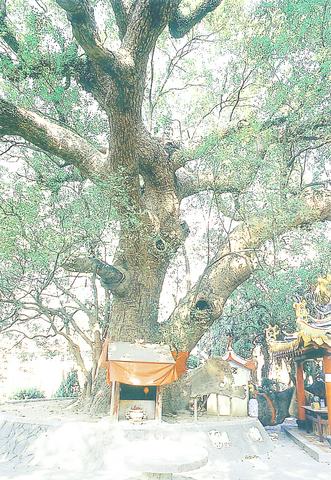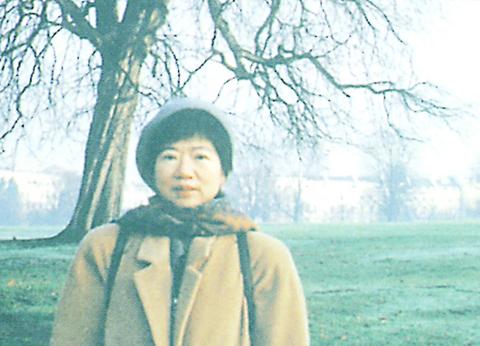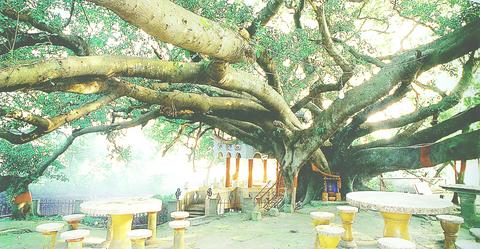The current trend toward localizing educational materials and recognizing the value of cultural and natural assets particular to Taiwan has combined with the government's promotion of domestic tourism to bring an increasing number of books on Taiwan's natural environment into bookshops.
People can carry such books with them when out in the mountains or exploring the coast. These books cover a wide range of subjects, including hiking trails, hot springs, birds, insects and flowers -- and a subject with a particularly Taiwanese flavor: old trees.
Several guide books on trees have been published over the last few years. The latest is A Map of Old Trees in Taiwan (

PHOTO COURTESY OF BIG TREE
The book documents 400 trees scattered around Taiwan. In addition to a photograph of the tree, its condition and environment are also profiled. There is also detailed information about the different types of trees, which is handy for novices.
Chang Huei-feng (
"It was then that I realized there were so many old trees in Taiwan. We could write about only the most famous ones because information on old trees was virtually non-existent," Chang said.

PHOTO COURTESY OF BIG TREE
Chang waited a decade before the first systematic record of old trees became available. This was in 1990, when the Taiwan Provincial Government's Agriculture and Forestry Bureau published a survey of 800 trees determined to be over 100 years old.
Chang's survey, which started in 2000, was based on the official record. The 400 trees in the book are the better preserved ones on which she could find background information. "Dozens of the listed trees have died in the 10 years since publication of the survey. More than a hundred are in poor condition," Chang said.
There was little or no follow-through on the Provincial Government's project, she pointed out.

PHOTO COURTESY OF BIG TREE
After the provincial administration was abolished in 1999, the job of documenting old trees fell to local governments.
"Very few local governments did anything at all about this," Chang said.
Chang is planning to send copies of her book to all the local government heads as a message that it is time for them to do something.
"It's much more efficient for local governments to take up the task of preserving old trees. As individuals, we can contribute very little," she said.
Individual efforts may not be able to drive home to the public the importance of old trees overnight, but there are people other than Chang who are willing to try. After her project was rejected by numerous photographers, Chang found Peng Chi-min (
After quitting his high school teaching job, Peng spent two and a half years traveling around Taiwan photographing the trees and finding out their histories. His only guide was the outdated government survey.
"It wasn't a well-funded journey. I spent nearly all my money on gas and equipment. Most nights I slept in my car by the roadside," said Peng, who was questioned by police numerous times during his travels.
It took from two days to two weeks to shoot a single tree. "Sometimes I had to wait for suitable weather. Sometimes I had to wait for the right kind of light. You had to be patient," Peng said.
For all the hardship, Peng saw his work on the book as a valuable chance to get in contact with "the wisdom of nature."
"The more I see of old trees, the more I understand Lao Tze's philosophy. The old trees survived by being humble, unassertive and accommodating," Peng said.
Peng used wide-angle lenses and shot from where people usually sit around the trees "to create a kind of closeness."
However, it's also evident from the photos that some of the old trees are not faring well. Several have their roots covered in concrete.
"People dealing with the trees had the idea that trees only need a small circle of soil around its base to survive. When the trees get in the way of new constructions, people pour concrete all around the tree, thinking that they are protecting it."
The fact is that they cannot absorb sufficient nutrition this way. "When residents see that the tree looks ill, they just cut off branches. It's sad," Chang said.
The most fascinating part of doing the book for both Chang and Peng was the discovery of traditional ways of life in Taiwan that centered on these trees.
Photos in the book show some trees tied with a red ribbon to signify their divinity. For every big tree, Taiwanese folk belief goes, there's a spirit living within.
Many old trees serve as a center of worship and people have built temples around them. Red cedars in Pingtung county, residents claimed, give children to couples and camphors in Kaohsiung are believed to protect families. Old tree worship remains remarkably strong.
During the lottery rage 10 years ago, a series of incidents were reported in which worshippers burned or poured acid on trees because they believed the trees had led them to bet on the wrong lottery number.
Chang thought these disfigured trees too terrible to look at and did not include them in the book. "It's such a shame," she said.
Stories like these show that old trees still have an important place in people's lives. "Old trees have been seen from only one perspective -- the ecological perspective. Their cultural significance has not been recognized. Cultural historians should try combining natural science and the human aspects of old trees to provide a broader perspective," Chang said.
Since the book's release, readers have posted messages with the publisher detailing information about old trees not mentioned in the book. The feedback, Chang said, proves that her book has raised people's awareness of old trees around them.
"It will take a long time to upgrade our preservation of old trees, but at least we have made a start," Chang said.

The unexpected collapse of the recall campaigns is being viewed through many lenses, most of them skewed and self-absorbed. The international media unsurprisingly focuses on what they perceive as the message that Taiwanese voters were sending in the failure of the mass recall, especially to China, the US and to friendly Western nations. This made some sense prior to early last month. One of the main arguments used by recall campaigners for recalling Chinese Nationalist Party (KMT) lawmakers was that they were too pro-China, and by extension not to be trusted with defending the nation. Also by extension, that argument could be

Aug. 4 to Aug. 10 When Coca-Cola finally pushed its way into Taiwan’s market in 1968, it allegedly vowed to wipe out its major domestic rival Hey Song within five years. But Hey Song, which began as a manual operation in a family cow shed in 1925, had proven its resilience, surviving numerous setbacks — including the loss of autonomy and nearly all its assets due to the Japanese colonial government’s wartime economic policy. By the 1960s, Hey Song had risen to the top of Taiwan’s beverage industry. This success was driven not only by president Chang Wen-chi’s

Last week, on the heels of the recall election that turned out so badly for Taiwan, came the news that US President Donald Trump had blocked the transit of President William Lai (賴清德) through the US on his way to Latin America. A few days later the international media reported that in June a scheduled visit by Minister of National Defense Wellington Koo (顧立雄) for high level meetings was canceled by the US after China’s President Xi Jinping (習近平) asked Trump to curb US engagement with Taiwan during a June phone call. The cancellation of Lai’s transit was a gaudy

The centuries-old fiery Chinese spirit baijiu (白酒), long associated with business dinners, is being reshaped to appeal to younger generations as its makers adapt to changing times. Mostly distilled from sorghum, the clear but pungent liquor contains as much as 60 percent alcohol. It’s the usual choice for toasts of gan bei (乾杯), the Chinese expression for bottoms up, and raucous drinking games. “If you like to drink spirits and you’ve never had baijiu, it’s kind of like eating noodles but you’ve never had spaghetti,” said Jim Boyce, a Canadian writer and wine expert who founded World Baijiu Day a decade